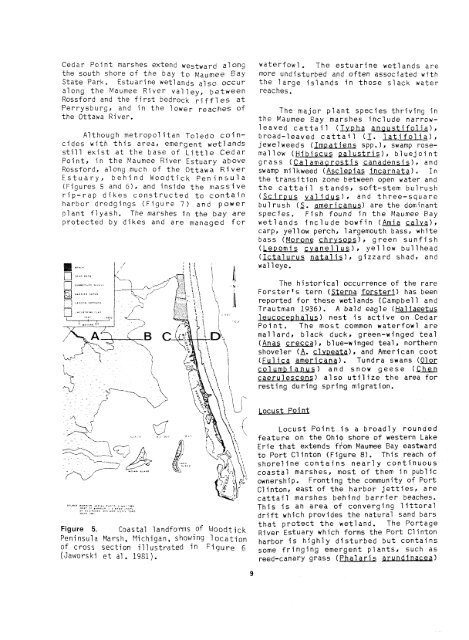The Ecology of coastal Marshes of Western Lake Erie: A Community ...
The Ecology of coastal Marshes of Western Lake Erie: A Community ...
The Ecology of coastal Marshes of Western Lake Erie: A Community ...
You also want an ePaper? Increase the reach of your titles
YUMPU automatically turns print PDFs into web optimized ePapers that Google loves.
Cedar Point marshes extend westward a1 ongthe south shore <strong>of</strong> the bay to Maumee 6ayStale Park. Estuarine wetlands a] so occuralong the Maumee River valley, betweenRossford and the first bedrock rjff 7es atPerrysburg, and in the lower reaches <strong>of</strong>the Ottawa River.Although metropol i tan Toledo coincideswith this area, emergent wetlandsstill exist at the bass <strong>of</strong> Little CedarPoint, in the Yaumee River Estuary aboveRossford, along much <strong>of</strong> the Ottawa RiverEstuary, behind Woodtick Peninsula(Figures 5 and G), and inside the massiverip-rap a i kes constructed to containharbor drndgings (Figure 7) and powerplant flyash. <strong>The</strong> marshes in the bay areprotected by dikes and are managed forwaterfowl, <strong>The</strong> estuarine wetlands aremore undisturbed and <strong>of</strong>ten assocfated withthe large islands fn those slack waterreaches.<strong>The</strong> major plant species thriving inthe Waumee Eay marshes include narrowleavedcattail (Tveha _aaaustifolia),broad-leaved cattail (I. J atifol iq),jewel weeds (Jm~at ienz spp. 1, swamp rosemallow(Hibiscus palustrls), bluejointgrass (Gal amaa rosti s canadensis), andswamp milkweed (Ascle~1~ incarnatal. Inthe transition zone between open water andthe cattai 1 stands, s<strong>of</strong>t-stem bulrush(Sci~pus validuq), and three-squarebulrush (5. americanu) are the dominantspectes. Fish found Sn the lilaumee Baywet1 ands include bowfin (m ~ alva),carp* yellow perch, largemouth bass, whitebass (MQrgn~hrys0~5)~ green sunfish(ie~omis svanel luq), yel low bullhead(Xctalurus natalis), gizzard shad, andwalleye.<strong>The</strong> historical occurrence <strong>of</strong> the rareForsterls tern (Sterna forstert) has beenreported for these wetlands (Campbell andTrautman 1936). A bald eagle (Hal iaeetusleucoce~hal(&aS) nest is active on CedarPoint, <strong>The</strong> most common waterfowl aremallard, black duck, green-winged teallm srecca) , blue-winged teal, northernshoveler (A. cl v~eata) , and Amer S can coot(Ful iu americana). Tundra swans (LUX~;olumbianu) and snow geese (Chencaerrrlesce~) also utilize the area forresting during spring migration.Locust PointFigure 5. Coastal la~dfonns<strong>of</strong> L.doodtickPeninsula Marsh, Michigan, showing 1 ocation<strong>of</strong> cross section illustrated in Figure 6(Jaworski et al. 1981).Locust Point is a broadly roundedfeature on the Ohlo shore <strong>of</strong> western <strong>Lake</strong><strong>Erie</strong> that extends f ram Maumee Bay eastwardto Port C1 inton (Flgure 8). This reach <strong>of</strong>shore1 ine contains near1 y continuous<strong>coastal</strong> marshes, most <strong>of</strong> them in pub1 icownership. Fronting the community <strong>of</strong> PortClinton, east <strong>of</strong> the harbor jetties, arecattail marshes behind barrier beaches.This is an area <strong>of</strong> converging Ilttoraldrift which provides the natural sand barsthat protect the wetland. <strong>The</strong> PortageRiver Estuary which forms the Port Clintonharbor is high1 y disturbed but containssome fringing emergent plants, such asreed-canary grass (ma1 ari s 1

















